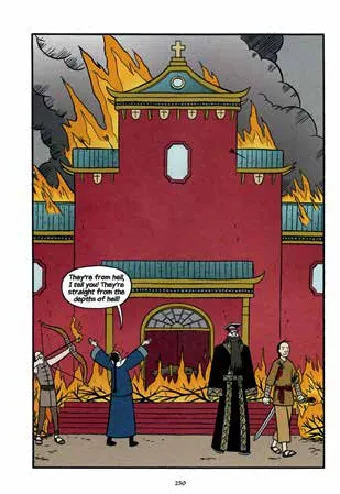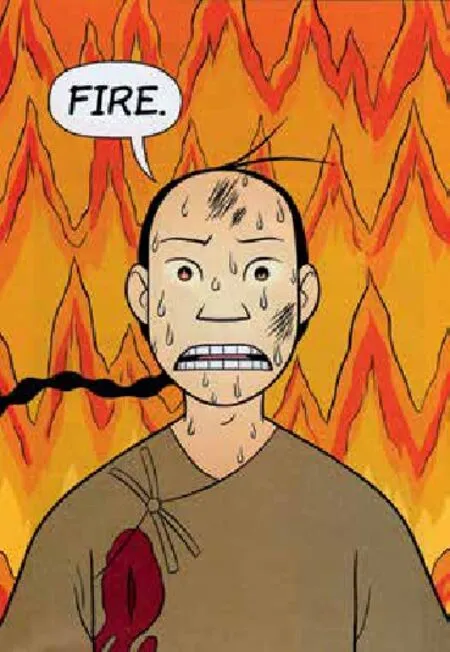MEANWHILE, DURING THE BOXER REBELLION…
2014-02-27BYTYLERRONEY
BY TYLER RONEY
MEANWHILE, DURING THE BOXER REBELLION…
BY TYLER RONEY
A look at innovation and history through Gene Luen Yang's Boxers & Saints
《义和团和圣徒》:杨谨伦画笔下历史与魔幻现实主义的交织



Little Bao, a boy who will grow to lead the brotherhood of the Righteous and Harmonious Fists to sack Beijing and drive the foreign devils from China's shores, sees the face of a young girl, known only as Four-Girl, whose sheer bloodymindedness contorts her face into a rictus of terror. They will meet once more: both are murderers in their own way, both are redeemed, and both are doomed—one by the other's hand.
Thus is the moral serendipity ofBoxers & Saints(《义和团和圣徒》), a pair of graphic novels by Chinese-American author and illustrator Gene Luen Yang (杨谨伦). There are few English-language graphic novels about China, even fewer for all age groups, and none that deal with the social complexities of the Boxer Rebellion. However, Yang brings all these together in an over 500 page graphic novel of precision and magical realism; he just can't resist: “Magical realism makes its way into all my books. I blame it on all those superhero comics I read as a kid.”
Yang fi rst became interested in the Boxer Rebellion in 2000, after Pope John Paul II canonized a group ofChinese Catholic Saints; he toldTWOC: “When I looked into the lives of the newly canonized, I discovered that many of them had been martyred during the Boxer Rebellion. They were killed because, back then, Chinese converts to Christianity were seen as traitors to their own culture.” He added, “The more I read about the Boxer Rebellion, the more fascinated I became. It was a struggle between identities. What makes a person truly Chinese?”



In a world containingSandman,Maus, andTransmetropolitan, the days when people thought graphic novels and comics were merely for children are over.Boxersitself which plays on Chinese mysticism in unfamiliar fashion; everything from the Monkey King and the Peach Tree Oath to the Taiping Rebellion and the warrior women of the Red Lanterns play a role in this graphic novel. And, while most of the roles these characters play are cursory—even imaginary—they are a breath of refreshing, surreal air in a dense political fog of war.
And, while Yang's book is innovative, there is just something about the heroes and magic of the myths and legends that speaks to both graphic novels and the history of the Boxer Rebellion: “I was struck by the similarities between the Boxers and modern day geek culture. The Boxers were inspired by China's mythic heroes in much the same way American geeks are inspired by superheroes. The Boxers watched their stories as operas performed by the traveling acting troupes of their day... And like modern geeks, they wanted to become their heroes.” He adds, “When today's geeks feel this impulse, we make colorful costumes and wear them to comic book conventions. The Boxers came up with a mystical ritual that called their heroes, their gods, down from the heavens.”
Yang himself spent six years on these two graphic novels, appearing last year, and already has been named a National Book Award Finalist and was theLos Angeles TimesBook Prize winner for young adult literature. His previous 2006 workAmerican Born Chinesewon accolades throughout America, not to mention his work on the internationally renownedAvatar:The Last Airbender.
And, whileBoxers & Saints sees some of the same mythologies (such as the Monkey King) and style, the theme of Boxers is an altogether different matter. The realism and violence ofBoxers & Saintsis dealt with carefully and tastefully, which Yang puts down to his own“prudishness”: “Boxers & Saintsis by far my most violentwork. As part of my research, I visited a Jesuit archive in France where they keep letters, black-and-white photographs, and other mementos of missionaries to China...They showed public executions, soldiers posing with headless corpses, and all sorts of other atrocities. I felt like I had to incorporate violence into my story in order to stay true to that time period.” However, Yang adds, “I drew much of the violence in a simplif i ed, cartoon style to make it more palatable. Plus, to be honest, I'm just not all that comfortable drawing gore.”
The Boxers ofBoxers & Saintsfollows Little Bao who, through a series of tragic incidents, seeks revenge on the“foreign devils” occupying his nation's capital and looks for retribution against Christians.
On his journey, Little Bao transforms in more ways than one. There is of course the metaphorical change from a boy of innocence to a man of war, but the more obvious alteration comes in the form of a magical revival. Through mystical powers often associated with the Righteous and Harmonious Fists—a group whose martial arts training and incantations were believed to make them invulnerable to Westerners guns—Little Bao and his merry band of fi ghters turn into symbols of Chinese culture, ones many of us are familiar with: the Monkey King, Liu Bei, and Guan Yu among others. With that, they are transformed from feeble peasants into superheroes of Chinese culture. “To a lifelong comic book reader like me, it (feels) like Shazam in late 1800s China,” says Yang.
Little Bao, though, is not one of these lofty literary icons; instead, he is Emperor Qin, China's fi rst emperor, the man who brought China together and is known today as both national icon and cruel despot. Such a metamorphosis gives Yang's tale a different hue to what one might expect. The book can just as easily read in a nationalist light as it can in one of dreamlike humiliation. Emperor Qin, for example, just as in real life, can be seen as either a heroic fi ghter doing what is necessary for his beloved land or a callous, murderous monster—the same, rather fi ttingly, can be said of Little Bao.
“Around the time of the Boxer Rebellion, people were predicting that China would not be able to remain unif i ed. Many expected the nation to break up into several smaller territories. That's why the Europeans and the Japanese were there—they each wanted their piece,”says Yang, “It seemed to me that Emperor Qin would have something to say about that, since the unif i cation of China was his life's work. That's why I brought him into the story. I also wanted to explore the fi ne line between patriotism and nationalism.”
The terse, simple explanations of mythic characters like the Pig Demon fromJourney to the Westmay seem plain, but they're less important as characters than symbols—signs of a dead and defeated China hoping to be reborn. On the Saints side ofBoxers & Saints, we have Four-Girl, a fourth child born on the fourth day of the fourth month—about as unlucky as you can get in Chinese numerology. Despised and mistreated, she seeks comfort in the spiritual, eventually, if not accidentally, landing in the arms of Christianity, a religion hunted by Little Bao and his army of Boxers.
While Four-Girl fi nds consolation in the arms of this strange Western religion and the acupuncture (crucif i xion) of its leader, it is more a story of alienation and uncertainty—not to mention that tiny part of all of us that just wants to be evil. Four-Girl's tale is far less mystical than Little Bao's story, but it is no less magical. Where Little Bao looks to the Emperor Qin for advice and inspiration (advice that is given with no moral ambiguity), Four-Girl's idol comes in the form of Joan of Arc who is less of a spiritual and tactical guide and more of a mentor that Four-Girl chases. To this, Yang says, “Four-Girl is caught between two cultures, and two ways of understanding Joan of Arc, her mentor. Was Joan a person of faith, like Four-Girl's Chinese Catholic friends, or a patriotic freedom fi ghter, like the Boxers? Four-Girl embodies struggle and doubt.”
Westerners in the graphic novel are given a thorough, yet arguably fair and comical, going over. Foreigners speaking—say, English, for example—are depicted speaking in gibberish symbols, a choice Yang made because, “I wanted to tell the story from the perspectives of the Chinese characters. Often, in older American comics, the word balloons of foreign characters are fi lled with gibberish. This gives those characters an aura of ‘The Other'. Westerners certainly felt like ‘The Others' to turn-of-the-century Chinese, so it seemed appropriate to apply the technique in that way.”
The world surrounding both Bao and Four-Girl is described vividly between the two main characters ofBoxers & Saints—in between the lines of the smashing of the heathen idol by Father Bey and the burning of Christians. In China, there is much debate about what the Boxers did; if it was justif i ed, what role the Dowager played, and so forth, and Yang uses this controversy (or rather lack of consensus) to craft two different worlds in the same country at the same time. To this day, the Century of Humiliation and issues of the Boxer Rebellion still inform the culture of China, poking their head in everywhere from video games to foreign affairs. For anyone of any age,Boxers & Saints is a perfect and entertaining way to start studying one of the most tumultuous times in Chinese history.
